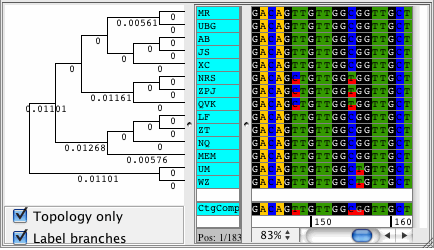The verb "to spit" may be one of
precious few words preserved from the common ancestor of all Eurasian languages. The word "huh," as in "what did you just say," has arisen* in
many languages around the world. These findings come from two of
several recent studies that use methods developed in evolutionary biology to discuss the evolution of language. Specifically, they employ a method called "
phylogenetics" that uses information about the characteristics of species to figure out their relationship to one another. There have been some basic errors,* as you would expect in a discipline taking up new methods. However, these studies hold promise for getting at questions about the history and spread of language, and also understanding how language evolves.
The fundamental assumption of
phylogenetics is that species descend with modification, and in theory the method should work for anything that does. Like language, or culture.
The new wave of linguistic and cultural phylogenetics is driven by the insight that languages and cultures, like species, evolve and diverge. But that insight itself is not new. The understanding that languages descend from each other
goes way back to before Charles Darwin was born, as
European explorers noticed that their tongues
shared similarities with Persian, Gujarati and other languages they encountered. Darwin himself gives a shout-out to the parallels in
The Origin of Species, saying:
 "Yet it might be that some ancient languages had altered very little and had given rise to few new languages, whilst others had altered much owing to the spreading, isolation and state of civilisation of the several co-descended races, and had thus given rise to many new dialects and languages. The various degrees of difference between the languages of the same stock would have to be expressed by groups subordinate to groups; but the proper or even the only possible arrangement would still be genealogical; and this would be strictly natural, as it would connect together all languages, extinct and recent, by the closest affinities, and would give the filiation and origin of each tongue."
"Yet it might be that some ancient languages had altered very little and had given rise to few new languages, whilst others had altered much owing to the spreading, isolation and state of civilisation of the several co-descended races, and had thus given rise to many new dialects and languages. The various degrees of difference between the languages of the same stock would have to be expressed by groups subordinate to groups; but the proper or even the only possible arrangement would still be genealogical; and this would be strictly natural, as it would connect together all languages, extinct and recent, by the closest affinities, and would give the filiation and origin of each tongue."
The possible application of phylogenetic methods range far and wide in anthropological, linguistic and sociological research. In addition to the linguistic papers cited above, researchers are now publishing papers about the phylogeny of
"Little Red Riding Hood",
Turkmen Textiles, and
marriage practices. Aside from just determining relationships, phylogenetic analysis can also tell us about which practices and language structures change faster or slower, which might hint at their centrality and importance. For example,
the first paper I cited in this post uncovered that the words for "we," "what," and "thou" are amongst the slowest-changing in the Indo-European language family.
However, there are many reasons to doubt that phylogenetics will be as successful at untangling linguistic or cultural relationships as it was for biological ones. Though biological evolution can be chaotic and hard to predict, the limited number of possible changes in DNA code (you only have four letters to work with) make it easier to
predict how likely different kinds of changes will be. In addition, there are rules for the flow of information such as the so-called "
Central Dogma" of molecular biology. While many, many exceptions have been found to these general rules, they provide a relatively stable framework to judge the likelihood of evolutionary events, which is crucial to building an accurate tree of relationships.
It remains to be seen whether these models of change can be worked out for linguistics or cultural evolution. Much depends on whether there actually are generalizable rules for the likelihood of developing an irregular verb, or changing a phoneme, or adding in certain plot points to your mythology. Perhaps the linguistic changes to English following the Norman invasion can someday be modeled like a
hybridization between two species. There are researchers
asking these questions, and the race is on to find
general rules of linguistic and cultural evolution.
I somehow doubt that these rules will emerge, though I hold out more hope in language than culture. Perhaps it is pessimism in the face of the complexity of the problem. Humans are wild and chaotic in the way we dance with our languages and cultures, subverting and transforming meanings and sounds, and making synesthetic connections between completely separate realms of thought. Maybe I harbor hope that that can't be fit into a mathematical model. In any event, the next few decades of linguistic and cultural research should be interesting to watch.
===================================================
*This is an example of a mistake that the authors made in their use of evolutionary language, and I will introduce some of that terminology here - if you're not really into evolution, this might be dry and it's OK if you stop reading now:
In the "huh" paper, the authors conclude that the word arose independently through "convergent" evolution without knowing if ancestral languages have this word. That is a basic mistake: convergent evolution is when a trait evolves in two separate lineages, but wasn't present in the common ancestor of those lineages.
If the word "huh" was convergent, then English and Hindi would both have the word "huh" but the Indo-European ancestral language that English and Hindi descent from would lack this word. The authors respond to that by basically saying that we should strip the term "convergence" of all meaning by "generalizing" it, citing
a paper that suggests merging the terms "parallel" and "convergent" evolution. Their argument is not very convincing":
"We use ‘convergent evolution’ as a general term for the independent evolution of similarities in form and function. When ancestral forms are known, a distinction can be made between form/function convergence in species that are closely related (‘parallel evolution’) versus in species that are not closely related (‘convergent evolution’). However, this distinction is not always consistently made in biology and recently there have been proposals to use ‘convergent evolution’ as a general term [76]. We use the term in this general sense. Our proposal accounts for the present-day cross-linguistic similarity of huh?, but has to remain agnostic as to its ultimate origins – in the absence of historical language data it is impossible to tell whether the present-day forms go back to one ancestral form (a stabilising evolution scenario[77]) or whether they arose independently in different languages (an independent convergent evolution scenario [78]). In either case, the selective pressures are the same."
But the distinction between convergence and parallelism is not whether the lineages are closely related, but whether the trait (the word "huh") evolved from different traits or the same trait in the ancestor. That is, it would be parallel evolution if the ancestor language of English and Hindi had a word "bleeble" that meant "huh", and that word changed to "huh" independently in both English and Hindi. There's no evidence for this either! The authors admit that it "is impossible to tell" whether the word "huh" is in so many languages because it was present in the ancestor of those languages or not, but go on to use the term "convergent evolution" in their title. Harumph!
 That said, the growth of the military-intelligence-industrial complex since 9/11 is unprecedented in its scope, brazen unconstitutionality, and lack of accountability or oversight. Collecting data (or metadata) about the communications of millions of citizens and non-citizens alike, without a warrant or an even a stated suspicion, is clearly a violation of the fourth amendment of the Constitution, no matter how much garbled legal justification the intelligence community condescends to toss us. Instead of allowing the NSA to collect the whole haystack in hopes of finding the needle, we need to return to traditional police work of following leads. As the fourth amendment declares: "no Warrants shall issue, but upon probable cause, supported by Oath or affirmation, and particularly describing the place to be searched, and the persons or things to be seized." If we choose as citizens to accept the NSA's assertion of authority to collect "things" (metadata is a thing) without warrant, we are agreeing to retreat on the fundamental ideals of our nation.
That said, the growth of the military-intelligence-industrial complex since 9/11 is unprecedented in its scope, brazen unconstitutionality, and lack of accountability or oversight. Collecting data (or metadata) about the communications of millions of citizens and non-citizens alike, without a warrant or an even a stated suspicion, is clearly a violation of the fourth amendment of the Constitution, no matter how much garbled legal justification the intelligence community condescends to toss us. Instead of allowing the NSA to collect the whole haystack in hopes of finding the needle, we need to return to traditional police work of following leads. As the fourth amendment declares: "no Warrants shall issue, but upon probable cause, supported by Oath or affirmation, and particularly describing the place to be searched, and the persons or things to be seized." If we choose as citizens to accept the NSA's assertion of authority to collect "things" (metadata is a thing) without warrant, we are agreeing to retreat on the fundamental ideals of our nation.

.jpg)
.jpg)

















